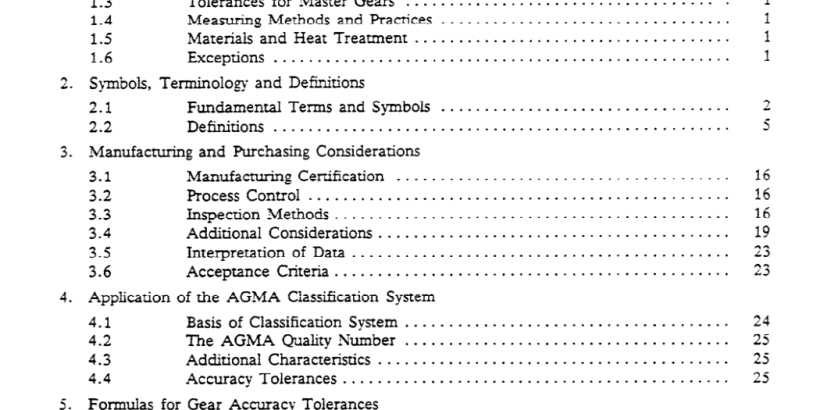ANSI AGMA 2000-A88 pdf download
ANSI AGMA 2000-A88 pdf download.GEAR CLASSIFICATION AND INSPECTION HANDBOOK
1. Scope
This Standard establishes a classification system which may be used to communicate geometrical quality specifications of unassembled external and internal involute gearing. It provides a designation system for quality, materials, and heat treatment of spur, helical (single or double), and herringbone gears. It also provides information on measuring methods and practices. This Standard provides the gear manufacturer and the gear buyer with a mutually advantageous reference for uniform tolerances and inspection procedures. Thirteen classes of quality levels are defined in this Standard, numbered Q3 through Ql.5, in order of increasing precision.
1.1 Equations for Tolerances. Equations for tolerances are provided for those who wish to compute the tolerances that define the quality of gearing in Section 5. The equations yield the same values as the tables. The accuracy tolerance formulas are valid for gears of a minimum size of 6 teeth through a maximum size of the lesser of 1 200 teeth or 400 inches (10 000 mm) pitch diameter.
1.2 Tolerance TabIes. Tolerance tables derived from the equations are provided which show the maximum values that are allowed by the specific Quality Number for a gear in Section 6. The tolerance tables in this Standard list the formula values for diametral pitches 0.5 through 1 20 (modules 50 through 0.2), and for gears ranging in numbers of teeth from 6 through 200.
1.3 Tolerance for Master Gears. Tolerances which define levels of quality for master gears are provided in Section 8.
1.4 Measuring Methods and Practices. Measuring methods and practices are included in order to promote uniform inspection procedures (see Section 9). These methods permit the user to conduct measuring procedures which are accurate and repeatable to a degree compatible Kith the specified quality. Experienced personnel, with calibrated instruments in suitable surroundings, are required.
1.5 Materials and Heat Treatment. A designation of the required material and heat treatment can be included as a part of the AG-MA Classification Kumber. Designation numbers are provided which identify gear materials, heat treatments, and hardness ranges (see Section 7).
1.6 Exceptions. This Standard does not apply to enclosed gear unit assemblies, including speed reducers or increasers, gear motors, shaft mounted reducers, high speed units, or other enclosed gear units which are sold on a rated horsepower basis for a given speed, ratio, or application. Gear design and backlash is beyond the scope of this Standard. Refer to the latest AGMA Publications Index for applicable standards. This Standard does not apply to gears larger than 400 inches (1 0 000 mm) in pitch diameter, or larger than 1 0 inches (250 mm) in face width, (per helix, if double helical or herringbone) ; or helix angles exceeding 45 degrees. NOTE: Tolerance values for gears outside the limits stated in this Standard should be established by determinin g the specific application requirements. This may require setting a tolerance smaller than calculated by the formulas in this Standard, particularly for tooth alignment of gears with face widths over 1 0 inches (250 mm).
2. Symbols, Terminology and Deftitions
The symbols, terminology and definitions pertaining to the tolerances and inspection of spur and helical gear teeth are listed here for use in this standard. For other definitions of geometric terms related to gearing, see AGMA 1 1 2 (ANSI B6.14), Gear Nomenclature. NOTE: Some of the symbols and terminology contained in this document may differ from those used in other documents and AGMA Standards. Users of this standard should assure themselves that they are using the symbols, terminology and definitions in the manner indicated herein.
n spur gears the profile angle is considered only in a transverse plane. In helical gears the profile angle may be considered in different planes. In specifications it is essential to use terms that indicate the plane which the profile angle lies, such as transverse or normal. Usually a single gear is stated in terms of the standard pitch and profile angle of the hob or cutter used to generate its teeth. (See AGhL4 Standard 11 2, para 9.1.)
